Los Angeles is home to a range of local environmental projects that invite community members to participate in sustainability efforts. By engaging in activities such as improving urban green spaces, cleaning beaches, and restoring wildlife habitats, residents can strengthen their connection to nature while contributing to the well-being of their community and environment.
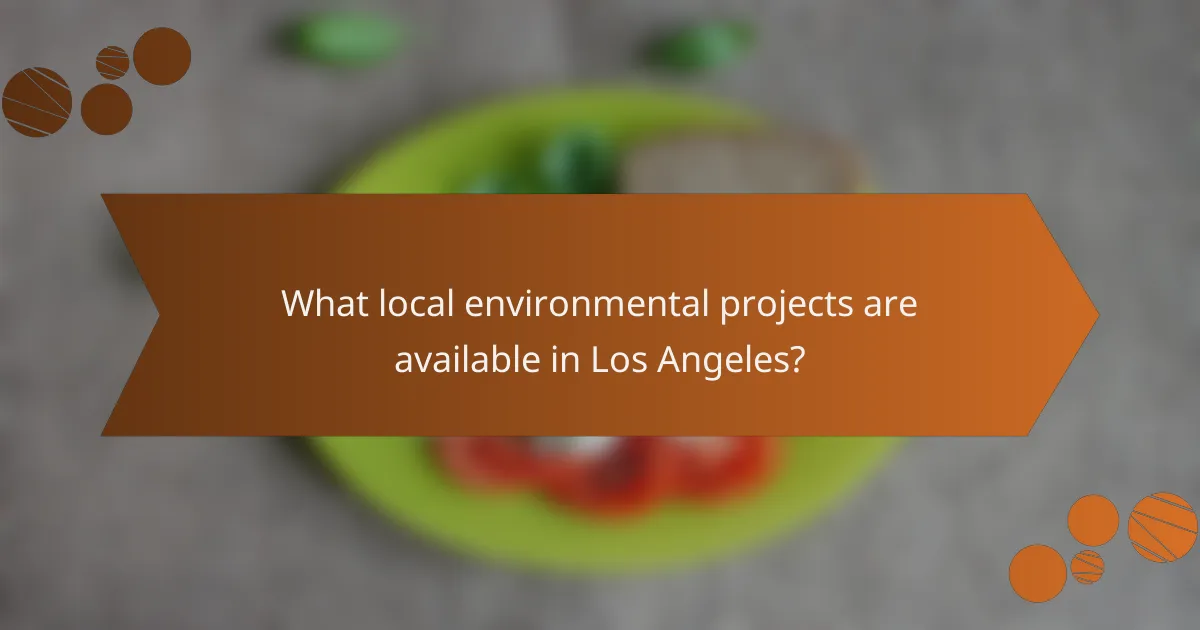
What local environmental projects are available in Los Angeles?
Los Angeles offers a variety of local environmental projects that engage the community in sustainability efforts. These initiatives focus on improving urban green spaces, cleaning local beaches, and restoring wildlife habitats, providing numerous opportunities for residents to get involved.
Tree planting initiatives
Tree planting initiatives in Los Angeles aim to increase urban greenery and improve air quality. Organizations like the City of Los Angeles and local non-profits often host events where volunteers can plant trees in parks and neighborhoods.
Participants typically receive guidance on proper planting techniques and care for the trees. It’s advisable to check local schedules, as these events often occur during the planting season, which is generally from late fall to early spring.
Beach clean-up programs
Beach clean-up programs are essential for maintaining the cleanliness and health of Los Angeles’ coastal areas. Various organizations, including Surfrider Foundation and Heal the Bay, organize regular clean-up events where volunteers can help remove litter and debris from the beaches.
These events usually provide all necessary supplies, such as gloves and trash bags. Volunteers are encouraged to wear comfortable clothing and sunscreen, and to check the weather forecast before attending.
Community gardens
Community gardens in Los Angeles promote local food production and foster community connections. These gardens allow residents to cultivate their own fruits and vegetables while participating in sustainable practices.
Joining a community garden typically involves a small fee for a plot, and participants often share responsibilities for maintenance and harvesting. It’s beneficial to research available gardens in your area, as some may have waiting lists or specific requirements for membership.
Wildlife habitat restoration
Wildlife habitat restoration projects focus on rehabilitating natural ecosystems in and around Los Angeles. These initiatives often involve removing invasive species, planting native vegetation, and restoring waterways to support local wildlife.
Volunteers can get involved through organizations like the Los Angeles Conservation Corps or local parks departments. Participants should be prepared for physical work and may need to attend training sessions to understand the restoration techniques being used.
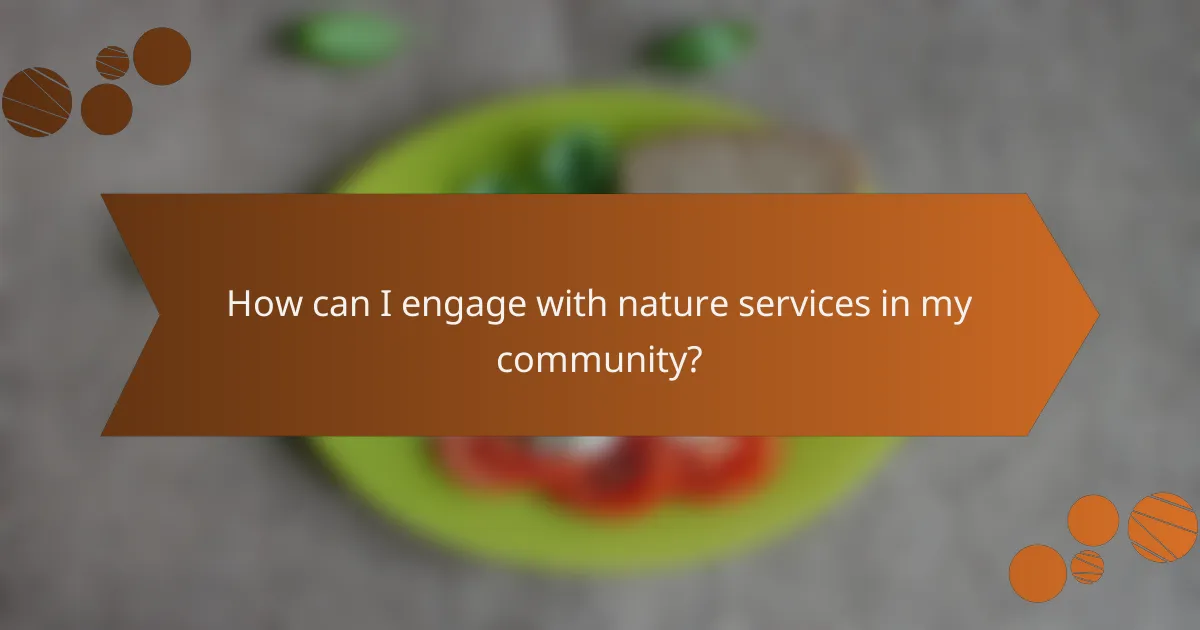
How can I engage with nature services in my community?
Engaging with nature services in your community involves participating in local environmental projects, volunteering, and attending workshops or events. These activities not only enhance your connection to nature but also contribute to the well-being of your community and the environment.
Volunteer opportunities
Many communities offer volunteer opportunities focused on conservation, habitat restoration, and environmental education. You can typically find these through local environmental organizations, parks, or community centers. Volunteering can range from a few hours a month to more intensive projects requiring regular commitment.
Consider joining initiatives like tree planting, clean-up drives, or wildlife monitoring programs. These activities often welcome individuals of all skill levels and provide training for new volunteers.
Community workshops
Community workshops are excellent ways to learn about local ecosystems and sustainable practices. These sessions often cover topics such as gardening, composting, and wildlife conservation. Workshops can be hands-on, allowing participants to apply what they learn immediately.
Check with local environmental groups or community centers for schedules and registration details. Many workshops are free or offered at a low cost, making them accessible to everyone.
Local environmental events
Local environmental events, such as festivals, fairs, or educational talks, provide opportunities to engage with nature services in a fun and informative setting. These events often feature guest speakers, interactive exhibits, and activities for all ages.
Stay informed about upcoming events through community bulletin boards, social media, or local news outlets. Participating in these gatherings can help you connect with like-minded individuals and discover additional ways to contribute to your community’s environmental efforts.
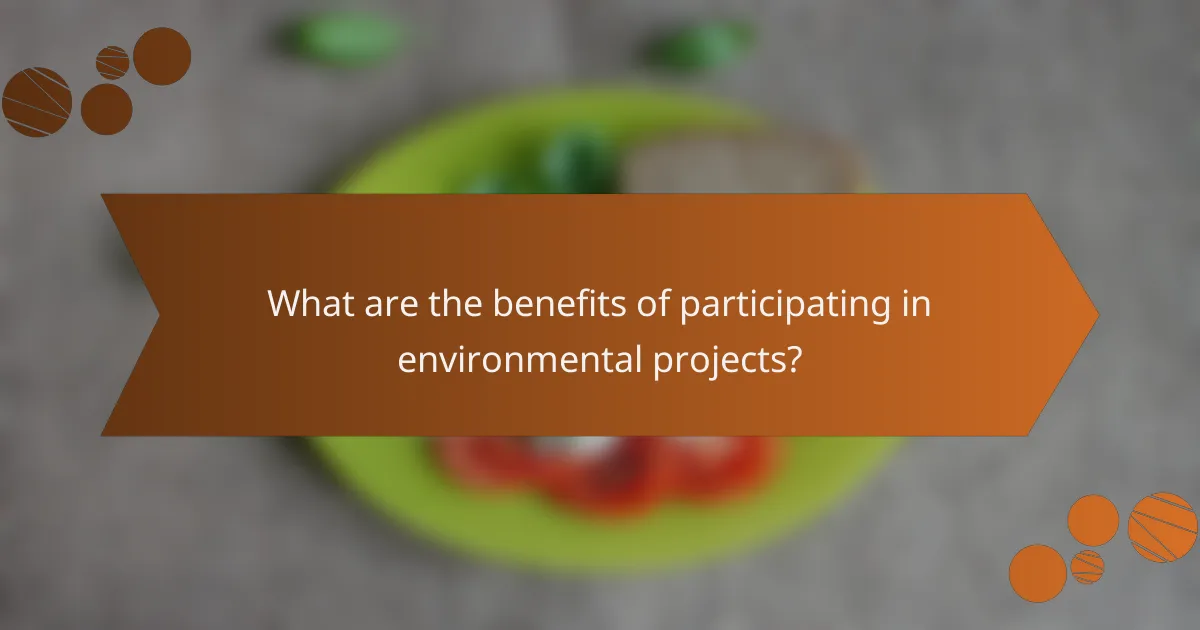
What are the benefits of participating in environmental projects?
Participating in environmental projects offers numerous benefits, including improved community health, enhanced local biodiversity, and stronger community ties. Engaging in these initiatives not only contributes to a healthier environment but also fosters a sense of belonging and collaboration among community members.
Improved community health
Environmental projects can significantly enhance community health by promoting cleaner air and water, reducing pollution, and encouraging outdoor activities. For example, community clean-up events can lead to reduced litter and improved aesthetics, which in turn can lower stress levels and increase physical activity.
Additionally, green spaces created through these projects can serve as recreational areas, providing residents with opportunities for exercise and social interaction. Regular participation in such initiatives can lead to long-term health benefits, including lower rates of obesity and chronic diseases.
Enhanced local biodiversity
Engaging in environmental projects helps to protect and restore local ecosystems, which is crucial for maintaining biodiversity. Activities such as tree planting, habitat restoration, and invasive species removal can create healthier environments for native plants and animals.
By improving habitats, these projects can increase the variety of species in a given area, which is essential for ecological balance. Community members can contribute by participating in local wildlife surveys or creating pollinator gardens, which support essential species like bees and butterflies.
Stronger community ties
Participating in environmental projects fosters stronger community ties by bringing people together for a common cause. These collaborative efforts can lead to lasting friendships and networks, as individuals work side by side to improve their surroundings.
Moreover, shared experiences during these projects can enhance community pride and ownership. Organizing regular events, such as tree planting days or clean-up drives, can help maintain engagement and encourage ongoing participation, further solidifying community bonds.
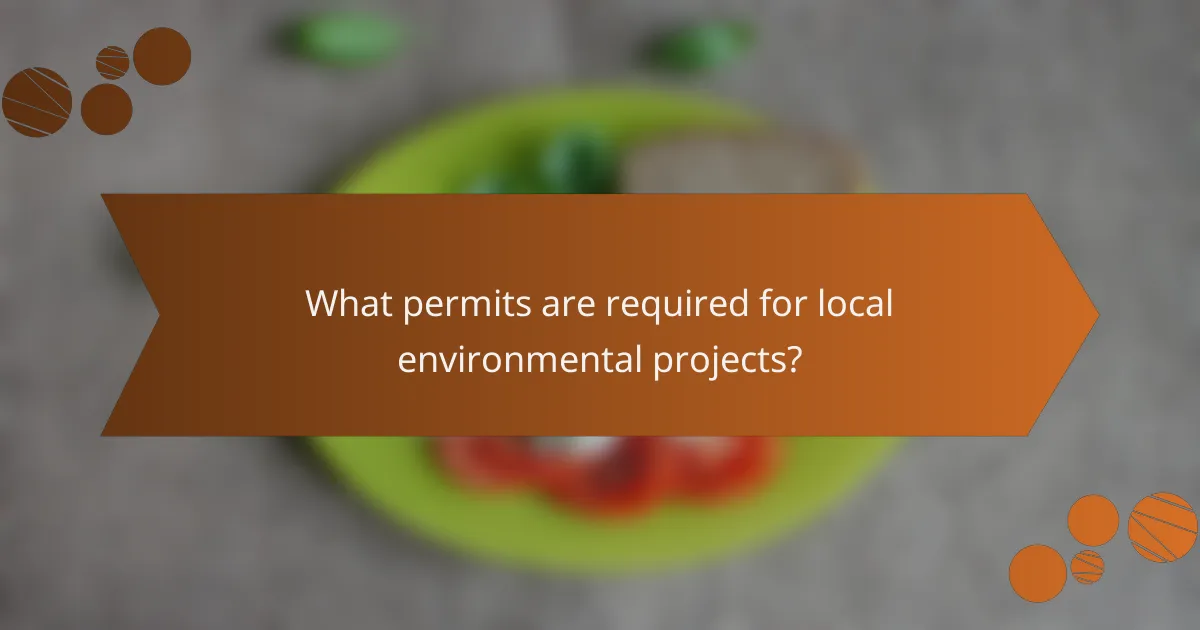
What permits are required for local environmental projects?
Local environmental projects often require various permits to ensure compliance with regulations and to protect natural resources. These permits can vary based on the project’s scope, location, and the specific activities involved.
City of Los Angeles permits
In Los Angeles, environmental projects typically need permits from the Department of City Planning or the Bureau of Engineering. Common permits include the Environmental Impact Report (EIR) for larger projects and the Minor Project Permit for smaller initiatives. It’s essential to check the specific requirements based on the project’s nature and location.
Additionally, projects that involve tree removal or modifications to public spaces may require additional permits. Engaging with local authorities early in the planning process can help clarify necessary permits and streamline approvals.
State environmental regulations
California has stringent state environmental regulations that govern local projects, including the California Environmental Quality Act (CEQA). This act mandates that any project with potential environmental impacts undergo a thorough review process. Depending on the project’s scale, this could involve preparing an EIR or a Negative Declaration.
Moreover, projects may need to comply with state regulations regarding water quality, air quality, and wildlife protection. Familiarizing yourself with these regulations is crucial, as non-compliance can lead to delays or fines. Consulting with environmental specialists can provide valuable insights into navigating these requirements effectively.
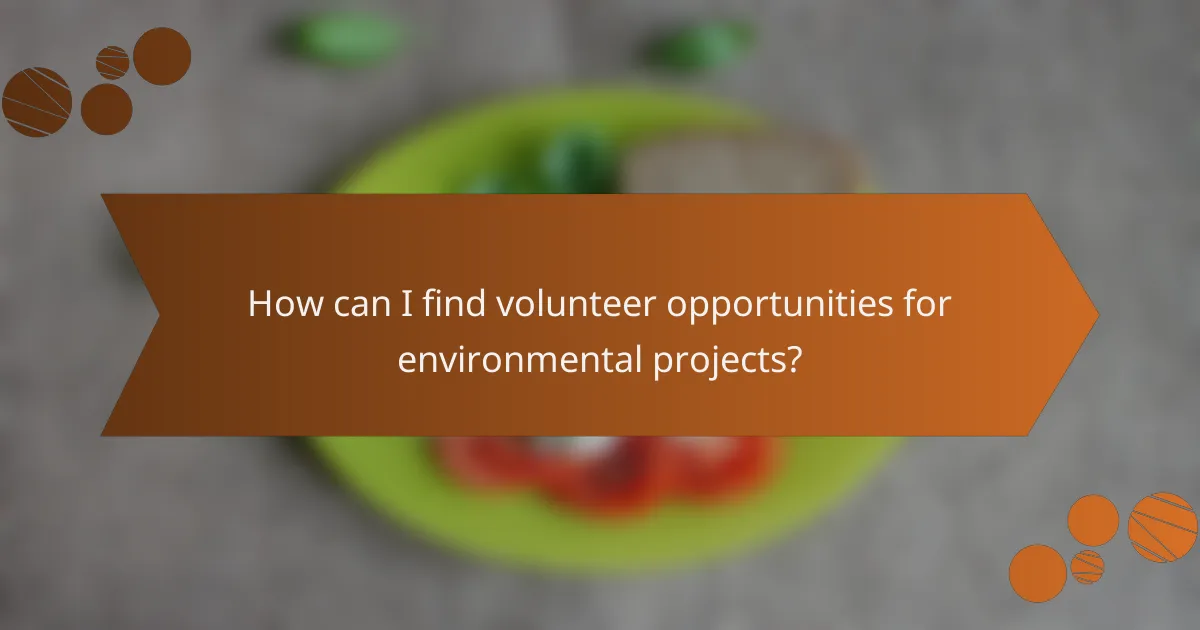
How can I find volunteer opportunities for environmental projects?
To find volunteer opportunities for environmental projects, start by researching local organizations and online platforms dedicated to conservation efforts. These resources often list various projects that need community support, making it easier to get involved.
Local non-profit organizations
Local non-profit organizations are a great starting point for finding volunteer opportunities in environmental projects. Many of these organizations focus on specific issues such as wildlife conservation, habitat restoration, or community clean-up initiatives. Examples include local chapters of larger organizations like the Sierra Club or smaller community groups dedicated to preserving local parks.
When engaging with these organizations, consider attending their events or informational meetings to learn about upcoming projects. Often, they will have volunteer coordinators who can provide details on how to get involved and what skills or time commitments are needed.
Online volunteer platforms
Online volunteer platforms serve as a centralized resource for finding environmental projects that need volunteers. Websites like VolunteerMatch or Idealist allow you to filter opportunities by location, interest, and commitment level. This can help you find projects that align with your skills and availability.
When using these platforms, create a profile that highlights your interests and experience. This can increase your chances of being matched with suitable projects. Additionally, be sure to read reviews and ratings of the organizations to ensure they are reputable and align with your values.
